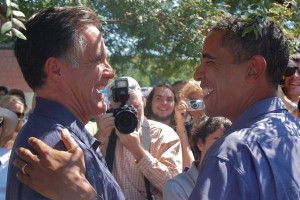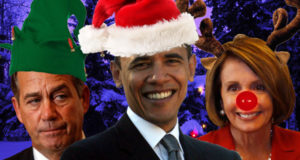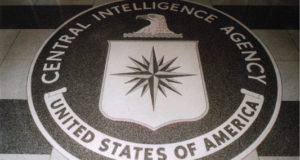Editor’s Note: Way Off the Grid is a satire feature of Off the Grid News. While the articles in this section may deal with current events, they are meant to portray these topics in a satirical and humorous light.
 NEW YORK – After struggling with bankruptcy for the past few decades, the two major political parties have agreed to consider joining forces as one national party. In a joint letter to employees of both parties, Republican and Democratic chairs Sharon Day and Debbie Schultz said Monday that since “the issues we pretend to fight about have dwindled drastically, while the costs of two parties arguing for the same things are skyrocketing, it now makes sense to evaluate a range of strategic options, including a potential merger.”
NEW YORK – After struggling with bankruptcy for the past few decades, the two major political parties have agreed to consider joining forces as one national party. In a joint letter to employees of both parties, Republican and Democratic chairs Sharon Day and Debbie Schultz said Monday that since “the issues we pretend to fight about have dwindled drastically, while the costs of two parties arguing for the same things are skyrocketing, it now makes sense to evaluate a range of strategic options, including a potential merger.”
Even party loyalists have warmed to the idea. “It’s been a long time coming,” said Florida Governor Jeb Bush, “but after watching the gross similarities of the candidates at both national conventions, it makes sense to eliminate the redundancies and repetitions.” Democrat Timothy Rahall came to the same conclusion. “Both candidates supported the bailout of Wall Street, the renewal of the Patriot Act, and opposed auditing the Federal Reserve,” noted Rahall. Republican Chris McDonnell added that “both candidates embraced subsidizing the auto industry, both claim to have developed the Obamacare plan, and both support the indefinite detention and bombing of suspect American citizens.”
In a national PEN/MIL poll conducted before the national party conventions, 93 percent of Americans consistently failed to distinguish policy positions between Republicans, Democrats, Elks Lodge, Rotary Club, and the Liberal Democratic Union Party of Albania.
“About 90 million eligible American votes will not be voting in the upcoming election,” said Democratic spokesperson Hugh Presley. “Both parties understand that many people don’t vote because they are a bit confused by the complexity of two parties.” He and others hope the planned merger will simplify ballots and lessen “the fear of moving a hand between option one and two.”
A growing consensus for the merger sees windfall savings by combining the two parties. “Both parties spend untold millions in opposition advertising, travel expenses, and lobbyists,” noted Republican secretary Rita Johnson. “Instead of wasting millions in redundancy,” she said, “we can combine funds and spend the money on more constructive things like, well, other things.”
Even though they oppose an unpopular president, the Republican Party has pushed the hardest for a merger with the Democratic Party. Republicans have run out of viable candidates in their farm system. Republicans had to overcome a publicity fiasco when they purchased Democrat Mitt Romney’s contract from Massachusetts in order appear like an opposition party. “He’s still learning the language,” said Republican Party organizer Sarah Leffer. “It’s hard to retrain Democrats, but he was the best we could get.” Leffer believes a merger would remove the need for such embarrassing contracts.
In addition, Republicans have long struggled to hire the coolest Hollywood celebrities to act like they like them. Celebrity prices continue to soar, and Democrats have long held the union contract closely. “We’re very much looking forward to replacing Clint Eastwood with George Clooney,” said Republican fitness expert Paul Ryan.
Democrats have not been passive in the merger process. In April, the DNC reached formal agreements with several traditionally Republican unions, including five in weapons manufacturing and three in the burgeoning fitness-and-fried-foods industry. Both parties have formal agreements to do whatever Microsoft, Apple, and Wal-Mart tell them to do.
Ray Jormach, a political analyst for Fluxom Group in New York, said the only potential snag in a Republican-Democratic merger is that “industries that survive on the traditional, faked disagreement between the two parties might riot in the streets.” He had no doubts that the new party could call in enough support to win a street scuffle from a united Sean Hannity and Rachel Maddow.
According to a Stanford poll, most Americans support the idea of a united Republican-Democratic party because one national convention wouldn’t pre-empt their favorite TV shows the way two did. Others point out that the television ratings of the two national conventions barely beat Storage Wars and Teen Mom.
“I worry about the hit the traditional presidential candidate debates might take,” observed ABC news anchor Bryan Paige. But merger spokesperson Annette Jennings said the two parties formed a committee early on to analyze that problem. “The debate will take on a bit of a new format, but it promises to be as tantalizing as ever,” she said. “The basic idea is that instead of debating each other, the two candidates will team up to debate against the American people as a whole.”
According to the Securities and Exchange Commission, there are still a number of steps that the two parties would need to take before a merger could actually move forward, including winning permission from United States creditors, like China, and, perhaps more importantly, how to share rooms in the White House.
Upon news of the potential merger, shares of Republican Party jumped 12.33 percent to 54 cents Wednesday while shares of the Democratic Party increased 1.51 percent to $14.12.
©2012 Off the Grid News
 Off The Grid News Better Ideas For Off The Grid Living
Off The Grid News Better Ideas For Off The Grid Living



